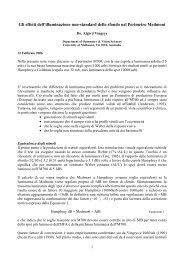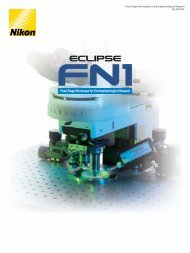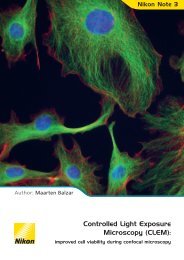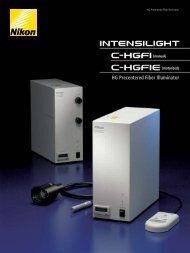Inverted Research Microscope ECLIPSE Ti - Nikon Instruments
Inverted Research Microscope ECLIPSE Ti - Nikon Instruments
Inverted Research Microscope ECLIPSE Ti - Nikon Instruments
Create successful ePaper yourself
Turn your PDF publications into a flip-book with our unique Google optimized e-Paper software.
4<br />
<strong>Ti</strong>: Stress-Free Operation<br />
High-speed Motorized Control<br />
and Acquisition<br />
The synchronized control of many motorized components such as the nosepiece,<br />
fluorescence filters, shutters, condenser turret and stage, allows researchers to use<br />
the microscope for a wide range of automated multi-dimensional experiments.<br />
Faster device movement and image acquisition decrease overall light exposure and<br />
subsequent photo-toxicity, leading to more meaningful data.<br />
Enhanced speed of individual motorized components<br />
Operation and/or changeover speed of objectives, filter cubes, XY stage, excitation/barrier filters has been greatly enhanced,<br />
realizing stress-free operational environment that enables researchers to focus on observations and image capture routines.<br />
The newly developed controller that memorizes and reproduces observation conditions and the joystick that enables<br />
stage control at will make the microscope feel like an extension of your eyes and hands.<br />
● High-speed XY stage movement ● High-speed Piezo Z stage movement ● High-speed epi-fl filter changeover<br />
<strong>Nikon</strong>-exclusive high-speed encoded stage <strong>Nikon</strong>-specified Piezo Z specimen stage <strong>Nikon</strong> filter dichroic cube turret<br />
Newly developed digital Controller Hub significantly increases<br />
motorized accessory speed by reducing the communication overhead<br />
time between components, boosting total operation speed.<br />
PC control and automation of the <strong>Ti</strong>’s motorized components are optimized to reduce the respective communication time between<br />
action commands and movements producing high-speed total control. By adding firmware intelligence to the microscope,<br />
total operation time of the motorized components is reduced. For example, the total time for continuous image acquisition in<br />
three modes (two-channel fluorescence and phase contrast) with illumination shutter control is greatly reduced enhancing cell viability.<br />
● Control process<br />
■ Conventional model<br />
Signal<br />
communication<br />
■ <strong>Ti</strong>-E<br />
Signal<br />
communication<br />
Stage movement<br />
Signal PFS Signal<br />
Filter changeover<br />
Signal<br />
Image capture<br />
communication correction communication<br />
communication<br />
Stage<br />
movement<br />
PFS<br />
correction<br />
Filter<br />
changeover<br />
Image<br />
capture<br />
Remarkably Fast Image Acquisition!<br />
Screening image capture of 96 wells in three modes (two-channel<br />
fluorescence and phase contrast) is possible at a speed of more than<br />
twice that of conventional models.<br />
Multipoint snapshots of HeLa cells transiently expressing Venus-tubulin and<br />
mCherry-actin and stained with Hoechst33342 and DiD. (All in pseudo-color)<br />
Photos courtesy of: Kenta Saito and Takeharu Nagai,<br />
<strong>Research</strong> Institute for Electronic Science, Hokkaido University
















